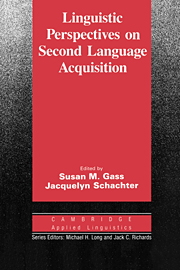Chapter 8 - How do learners resolve linguistic conflicts?
Published online by Cambridge University Press: 05 October 2012
Summary
This chapter deals with issues of second language performance – in particular, with ways in which learners interpret second language sentences. Current research in second language acquisition is primarily concerned with the acquisition of independent parts of a learner's linguistic system. In fact, most chapters in this volume deal with only one linguistic level. Departing from this tradition, this chapter attempts to consider aspects of learners' performance by focusing on the ways in which syntax, semantics, and pragmatics simultaneously influence learner interpretive behavior. An assumption underlying this is that language development is interactive. In acquiring either a primary or a nonprimary language, one does not learn syntax and then semantics and then pragmatics. Instead, at a single point in time a learner deals with all three as well as with other aspects of the grammar. Thus, a composite picture of the nature of second language acquisition must include studies investigating the simultaneous acquisition of grammatical components.
The influence of the native language in second language acquisition has been a matter of concern for a number of years (for detailed descriptions of recent research, see Gass and Selinker 1983; Kellerman and Sharwood Smith 1986). A central question in second language research is ultimately concerned with the ways in which conflicts in language systems (the native language and the target language, as well as other languages known [see Ringbom 1976]) are resolved. The question then becomes: What kinds of linguistic information assume importance for second language learners and at what stage in their development?
- Type
- Chapter
- Information
- Linguistic Perspectives on Second Language Acquisition , pp. 183 - 200Publisher: Cambridge University PressPrint publication year: 1989
- 23
- Cited by



